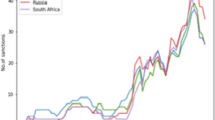Abstract
In this paper, the impact of the adoption of the euro on the commercial transactions of EMU countries is investigated. It seeks to disentangle the effects of eliminating exchange rate volatility — and those of other policy factors that promote integration — from the influence of the emergence of the European currency union. Since EMU is a relatively new phenomenon, a panel estimation of the gravity equation in a dynamic framework is used in order to capture effects like trade persistence. The main finding is that the adoption of the euro has had a positive but not an exorbitant impact on bilateral trade between European countries (ranging between 9 and 10 per cent). The impact is much lower than that shown in the recent literature on a larger and heterogeneous set of countries. One reason for this divergence seems to be that the euro was adopted after decades of integration policies had already worked through in Europe. JEL no. F4, F15, C230
Similar content being viewed by others
References
Alesina A., R. J. Barro, and S. Tenreyro (2002). Optimal Currency Areas. HIER Discussion Paper 1958. Harvard Institute of Economic Research, Cambridge, Mass.
Anderson, J., and E. van Wincoop (2001). Gravity with Gravitas: A Solution to the Border Puzzle. NBER Working Paper 8079. National Bureau of Economic Research, Cambridge, Mass. Published 2003 inAmerican Economic Review 93 (1): 170–192.
Arellano, M., and S. Bond (1991). Some Tests of Specification for Panel Data: Monte Carlo Evidence and an Application to Employment Equations.Review of Economic Studies 58 (2): 277–297.
Baltagi, B. H. (2001).Econometric Analysis of Panel Data. New York: John Wiley.
Belanger, D., S. Gutierrez, and J. Raynauld (1992). The Impact of Exchange Rate Variability on Trade Flows: Further Results on Sectoral U.S. Imports from Canada.North American Journal of Economics and Finance 3 (1): 61–82.
Brada, J., and J. Mendez (1988). Exchange Rate Risk, Exchange Rate Regime and the Volume of International Trade.Kyklos 41 (2): 263–280.
Bun, M., and F. Klaassen (2002). The Importance of Dynamics in Panel Gravity Models of Trade. Uva Discussion Paper 2002/19. Universiteit van Amsterdam.
De Grauwe, P., and F. Skudelny (2000). The Impact of EMU on Trade Flows.Weltwirtschaftliches Archiv/Review of World Economics 136 (3): 381–402.
Egger, P. (2000). European Exports and Outward Foreign Direct Investment: A Dynamic Panel Data Approach. WIFO Working Paper 129. Österreichisches Institut für Wirtschaftsforschung, Wien.
Eichengreen, B., and D. A. Irwin (1996). The Role of History in Bilateral Trade Flows. NBER Working Paper 5565. National Bureau of Economic Research, Cambridge, Mass.
Estevadeordal, A., A. B. Frantz, and A. Taylor (2003). The Rise and Fall of World Trade, 1870–1939.Quarterly Journal of Economics 118 (2): 359–407.
Frankel, J., and A. K. Rose (2000). Estimating the Effect of a Currency Union on Trade and Output. NBER Working Paper 7857. National Bureau of Economic Research, Cambridge, Mass.
Frankel, J., and S. Wei (1993). Trade Blocks and Currency Blocks. NBER Working Paper 4335. National Bureau of Economic Research, Cambridge, Mass.
Glick, R., and A. K. Rose (2002). Does a Currency Union Affect Trade? The Time-Series Evidence.European Economic Review 46 (6): 1125–1151.
Head, K., and T. Mayer (2002). Illusory Border Effects: Distance Mismeasurement Inflates Estimates of Home Bias in Trade. CEPII Working Paper 2002-01. Centre d’Études Prospectives et d’Informations Internationales, Paris.
Levy Yeyati, E. (2003). On the Impact of a Common Currency on Bilateral Trade.Economic Letters 79 (1): 125–129.
Linnemann, H. (1966).An Econometric Study of International Trade Flows. Amsterdam: North-Holland.
Lockwood, B. (2000). Discussion on “One Money, One Market: The Effect of Common Currencies on Trade”.Economic Policy 15 (30): 34–35.
Lopez-Cordova, E., and C. M. Meissner (2003). Exchange-Rate Regimes and International Trade: Evidence from the Classical Gold Standard Era.American Economic Review 93 (1): 344–353.
Melitz, J. (2001). Geography, Trade and Currency Unions. CEPR Discussion Paper 2987. Centre for European Policy Research, London.
Micco, A., E. Stein, and G. Ordonez (2003). The Currency Union Effect on Trade: Early Evidence from EMU.Economic Policy 18 (39): 315–356.
Pakko, M., and H. Wall (2001). Reconsidering the Trade Effects of a Currency Union.Federal Reserve Bank of St. Louis Review 83 (5): 37–45.
Persson, T. (2001). Currency Unions and Trade: How Large Is the Treatment Effect?Economic Policy 33 (16): 435–448.
Quah, D. (2000). Discussion on: “One Money, One Market: The Effect of Common Currencies on Trade”.Economic Policy 30 (15): 35–38.
Ritschl, A., and N. Wolf (2003). Endogeneity of Currency Areas and Trade Blocks: Evidence from the Inter-War Period. Working paper, Humboldt University, Berlin. Available at www.wiwi.HU-Berlin.de/WG/Ritschl/AL_WP.HTML
Rose, A. K. (2000). One Money, One Market: The Effect of Common Currencies on Trade.Economic Policy 30 (15): 7–45.
Rose, A. K. (2001). Currency Unions and Trade: The Effect Is Large.Economic Policy 33 (16): 449–461.
Rose, A. K. (2002). The Effect of Common Currencies on International Trade: Where Do We Stand? MAS Occasional Paper 22. Economic Department, Monetary Authority of Singapore. Available at http://faculty.haas.berkeley.edu/arose/RecRes.htm
Rose, A. K., and C. Engel (2000). Currency Unions and International Integration. NBER Working Paper 7872. National Bureau of Economic Research, Cambridge, Mass.
Rose, A. K., and E. van Wincoop (2001). National Money as a Barrier to International Trade: The Real Case for Currency Union.American Economic Review 91 (2): 386–390.
Tenreyro, S. (2001). On the Causes and Consequences of Currency Union. Mimeo. Harvard University, Cambridge, Mass.
Tenreyro, S., and R. J. Barro (2003). Economic Effects of Currency Unions. NBER Working Paper 9435. National Bureau of Economic Research, Cambridge, Mass.
Author information
Authors and Affiliations
Corresponding author
About this article
Cite this article
de Nardis, S., Vicarelli, C. Currency unions and trade: The special case of EMU. Review of World Economics 139, 625–649 (2003). https://doi.org/10.1007/BF02653107
Issue Date:
DOI: https://doi.org/10.1007/BF02653107




